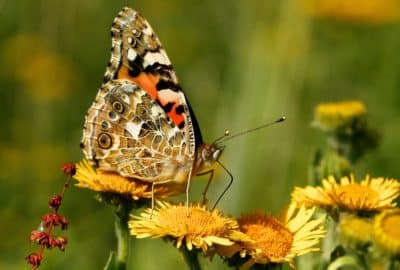Why am I killing my house plants?
Wednesday 24th Apr 2024, 11.30am
House plants can be a cheerful pop of colour in your home. But do you find after the initial burst of life, your plants start to fade, looking sad and unhealthy?
M Garrido Davies, from the Department of Biology, shares top tips for helping house plants to flourish, starting with learning more about the biology of how plants grow in their natural environment.
Did you know that when you add too much water to your house plants, it starves their roots of oxygen, damaging the root system and actually creating a drought? And have you considered how much light and ventilation your household greenery is getting?
Discover more biology behind the blooms in this podcast!
Emily Elias: When it comes to houseplants, I have the best of intentions, but somehow they do not last long. Their leaves go brown, they slowly fade away and then I’m just left with this, like, pot of mushy dirt.
Well, on this episode of the Oxford Sparks Big Questions podcast, we are asking, why am I killing my houseplants?
Hello, I’m Emily Elias, and this is the show where we seek out the brightest minds at the University of Oxford, and we ask them the big questions. And for this one, we have found a researcher who’s ready to dig deep into the dirt and help us sort all of this out.
M Garrido Davies: I am M Garrido Davies. I am a PhD student in plant biochemistry at the University of Oxford.
Emily: And you are not necessarily studying house plants all the time, but you’ve graciously said you can help me with this big question today.
M: Yes. So, in my day job, I study potatoes and look at their importance as an agricultural crop but to a certain extent, all plants have the same problems. So, a lot of my research on potatoes can be applied to other plants as well.
Emily: Okay, well, let’s dive into some of these problems. So, myself and my colleague, Fiona, we have been discussing this for a while that for some reason, we cannot seem to keep our house plants alive. And we don’t feel like we are alone in this struggle. So we’re hoping that you can help shed some light on this. What is something that possibly we’re doing wrong that is causing our plants to perish?
M: So, the place I like to start to take a leaf out of Eric Allen’s book is to say that knowing how a plant grows shows us how to grow that plant. So the first thing is, what plant am I growing? Because different plants have different needs. And there may be a range of things you could be doing wrong.
A lot of them might relate to water, which is my area of expertise. So I study what happens when potatoes get too much water, and the same can happen to your house plants. So if you’re treating a cactus, for example, which grows in a very well drained soil, sees hardly any rain at all. If you’re overwatering that to the extent that you might water a tropical plant, which sees rainstorms every day, then you might get an overwatering problem.
So the way that I like to explain this is that we as humans, if we find ourselves in a big deluge like a swimming pool, we’re able to move and go to the top of the water for air. But plants aren’t able to do that. If they’re rooted, they’re stuck where they’re rooted. They can move between generations, but a certain generation can’t necessarily move. So the plant has to adapt the way it grows to cope with different amounts of water. So a tropical plant and a desert plant have evolved completely different ways of dealing with water and so if you underwater a tropical plant, it might wilt and die. But a desert plant, if you overwater, that might have the same effect.
So what’s really interesting with plant root systems is that when we overwater them, the root systems are starved of oxygen and then they can die off. And then when that water goes away, just either by a flood receding or by just evaporating out of your pot, then that root system might be damaged and a plant might be left with fewer roots, less ability to take up water. So you can actually drought a plant by overwatering it, which is really interesting. So that wilt that you see in a plant, always make sure you touch the soil, because a plant might wilt from overwatering the same way it wilts from underwatering.
Emily: Okay, I’m totally guilty of that. I have that sort of thing where I forget that I watered the plant and then I overwater it, and then I forget the plant exists for a while.
So, yeah, okay. That could be part of my problem. I’m causing my plant to drown and then dry out and then have a drought.
M: Yes. So touch that soil and if you find that you let your plant dry out, some plants can cope with a really heavy watering, but it might actually be sensible to water little and often to recover from a drought rather than going straight in for a massive deluge of water because that’s just stress upon stress for the plant.
Emily: What about where I keep my plants. Because I have this cat and she just wants to eat all of them. So I tend to have to hide them in the bathroom quite often. And maybe that’s not the best place for my plants.
M: Yeah. So with house plants, we often see something that we don’t have in the greenhouse, which is light problems. So again, a plant that’s used to growing on the forest floor with all the leafy canopy over it, might be fine in your bathroom because it doesn’t really need that much light, especially if you’ve got a window in your bathroom. I would not recommend trying to grow plants in rooms with absolutely no sources of light. But that deep shade isn’t necessarily an essential problem if you choose the right plant for that place.
But on the opposite end of the spectrum, if you have a south facing window that gets all the light in the summer, that can end up giving your plant too much light. So if we go back to cacti, which are common house plants, because they grow in the desert, they are really used to having high intensities of light impacting on their leaves, and they have mechanisms to adapt to that.
But other plants don’t so much, and they might get what we call bleaching. So their leaves might go a, kind of a yellowy colour, or even white from too much light if you’re really looking at an intense south facing window with the summer light on it all the time.
But in a way, it relates back to the swimming pool analogy that we were talking about earlier. So what light does, it doesn’t only drive photosynthesis, which is what plants need to do, it also drives evaporation. So if you’re watering a plant, and it’s in this south facing location where it’s getting lots and lots of light and heat from the window, it’s going to evaporate much quicker. And you might end up droughting the plant if you don’t compensate for that by watering more.
On the opposite end of the scale, if you’re putting your plant in a bathroom corner where it’s not really getting much light, but it’s also not getting much ventilation, that will lead to a really humid atmosphere where you’re not evaporating at all. And that means that if you don’t adapt your watering by watering less, you’re going to end up back in that swimming pool with way too much water around the roots.
Emily: Okay, so this all makes sense. What about the soil that the plant comes in? When I get it from the plant shop, do I need to repot it right away or is it fine to just like, be in that container that it’s coming in? Is there sort of special considerations I need to give about the soil?
M: So, again, this will depend on the plant. But something you can do if your plant is in a reasonably small pot is just try lift it slightly out of the pot if it has a strong woody stem. If it doesn’t, you can try and dig with your finger outside the edge of the pot. And if the soil feels like it’s one unit, or if you are able to kind of lift the plant out of the pot slightly and you see this root ball all around the edge of the pot, that means that your plant is pot bound.
So you would see this with herbs that you might buy from the supermarket in a little pot. They have really, really dense root systems because they are made to be harvested once and then thrown away. If you want to keep that plant going, what you want to do is pot it up, put it in a bigger pot with more compost, tease out those roots that are completely going round and round in circles in the pot. You might have to break them up a little bit just so that the roots spread throughout the pot rather than just going round and round in circles on the outside. That’s important in soil. However, we also want to think about feeding. So people might complain that their orchid plant, it’s not dead, but it’s not doing anything.
Emily: Yeah, I have like those really big leaves, but then I don’t seem to get actual shoots of the flower to grow again.
M: So plants need different nutrients to be able to grow vegetatively, so grow leaves and stems, than they do to be able to flower. And some plants, orchids are a particular example of this with house plants, they really need a helping hand when it comes to flowering. So buying some plant feed would be a good idea in that case. Have a look at your garden centre. It will say feed to encourage growth or feed to encourage flowering. They’re relatively easy to distinguish from each other, but then also be careful of overfeeding.
So when you think about the way plants grow in the wild, very, very few of them flower in winter. And that’s why generally we want to hold off the watering and the feeding in winter and we want to bring them back to life in spring and summer. Again, coming back to cacti can be quite sensitive if they’ve gone into kind of their winter growth stalling phase and then you water them or feed them, that’s actually really not good for the plant.
Emily: Oh, no, I did that the other day.
M: Yes. So drain where you can and cross your fingers and hope best.
Emily: Okay. These are all incredible tips. Some of the plants that I have, I don’t actually know what they are, though. Like, they’ve just kind of been handed to me by, like, a friend or a neighbour who kind of just left it in the communal stairwell. How do I figure out, like, what plants are so that I know how to treat them and what type of soil they’ll need and what type of sunlight they need? Where do I get all this information from?
M: So there are definitely places where you can get this information. I would encourage listening to your plant first, because if you actually take the time to really look at your plant, your plant will tell you things. You’ll touch the soil, your plant will tell you whether it’s wet or dry. Your plant will tell you whether it’s too dark or whether it’s way too light.
Another thing to do, especially if it’s a house plant that you’ve seen in other people’s houses as well, just pop to a garden centre or a garden centre’s website and you might see a picture of your plant advertised with the name. But also what’s really useful is to use the people in your community.
Another really great tool is the RHS. So they’re the Royal Horticultural Society, and on their website they have both a plant finder, so an app that allows you to identify plants from photos, and not only do they give you an identification, but they also give you an idea of how confident they are in that identification so that you can look at other options if they’re not very confident. But they also have excellent resources on how to care for individual types of plants, that’s both plants that you might grow in your garden, but they also have a whole section that’s dedicated to houseplants and to how best to care for them.
Emily: Thank you so much, M. I promise I will not spam you pictures of my house plants and I will go seek other help so that you don’t get inundated with my request of identifying my personal struggle.
M: Yes, because to tell you a secret, I’m a molecular plant scientist, I’m not a botanist, so I would be probably just as bad as you are at identifying plants.
Emily: You know how to keep them alive and that’s the most important part!
M: That I do!
Emily: This podcast was brought to you by Oxford Sparks from the University of
Oxford, with music by John Lyons and a special thanks to M Garrido Davies.
Tell us what we think about this podcast and send us pictures of your dying house plants. We are on the internet at oxfordsparks.ox.ac.uk or @oxfordsparks on your social media handles.
I’m Emily Elias. Bye for now.





